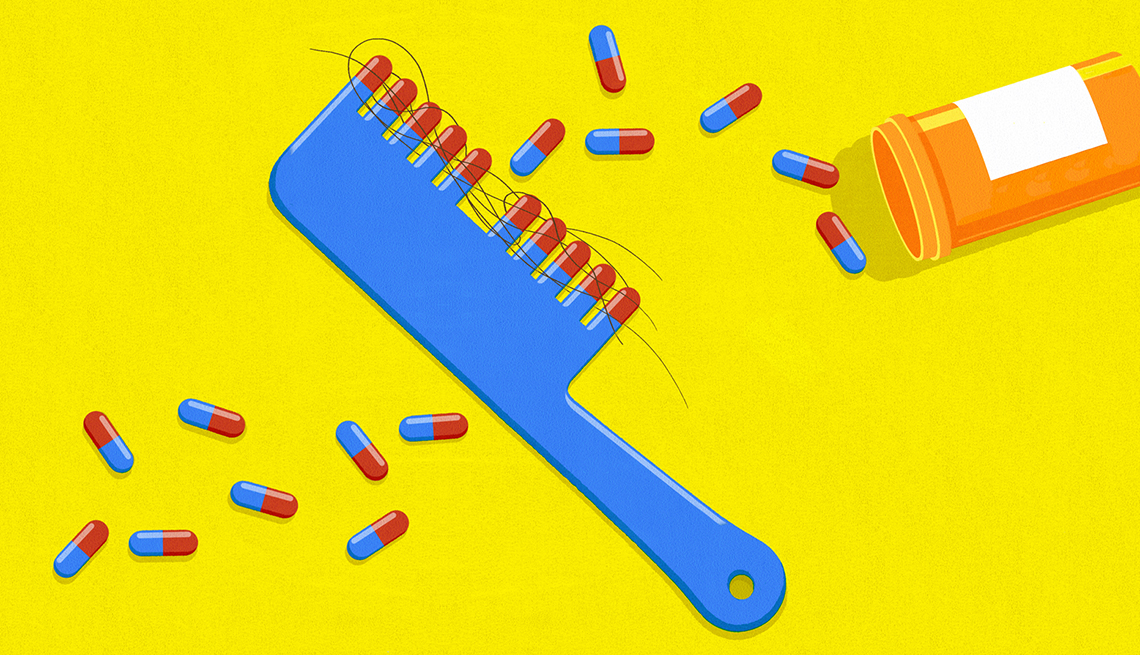
10 types of drugs that could cause hair loss
- Select a language for the TTS:
- UK English Female
- UK English Male
- US English Female
- US English Male
- Australian Female
- Australian Male
- Language selected: (auto detect) - EN
Play all audios:

TREATMENT OPTIONS FOR HAIR LOSS In some instances, hair loss can be reversed by changing the medication dosage, prescribing the brand-name drug (or an alternative drug), or adding B vitamins
or folic acid. Still, even after the source is identified, it could take six months for the hair to begin growing back. Board-certified dermatologist Danilo C. Del Campo, M.D., from Chicago
Skin Clinic, suggests a variety of treatment options: * DISCONTINUING OR SUBSTITUTING OFFENDING MEDICATION: If possible, switching to an alternative drug that doesn’t cause hair loss can
help. This should only be done under the guidance of the prescribing physician to ensure the underlying condition remains treated. * TOPICAL TREATMENTS: A widely used over-the-counter
topical medication, minoxidil, can stimulate hair growth and increase its density when applied directly to the scalp. * ORAL TREATMENTS: Typically used for male-pattern baldness, finasteride
can be prescribed to reduce follicle miniaturization in specific types of hair loss. * INJECTIONS: Hair growth can be promoted through injectable forms of minoxidil or platelet-rich plasma
(PRP), which uses concentrated platelets from a patient’s blood to enhance hair follicle function and stimulate growth. * NUTRITIONAL SUPPORT: A diet rich in essential vitamins and minerals
is crucial for healthy hair. Supplements such as biotin, zinc and iron can help if there is a deficiency. Consult with a nutritionist or dietitian to create a personalized diet plan. *
HEALTHY LIFESTYLE HABITS: Eating a balanced diet, getting adequate sleep, exercising regularly and decreasing stress are important for preventing, minimizing or reversing medication-induced
hair loss, Mirmirani says. HOW TO TREAT HAIR LOSS FROM CHEMOTHERAPY “Cold capping is the most effective way to prevent chemotherapy-associated hair loss,” says Jane Lowe Meisel, M.D., an
oncologist at Emory University’s Winship Cancer Institute. It involves wearing a cold cap for a set period before and after an infusion, which constricts blood vessels in the scalp. This
reduces blood flow and limits the exposure of hair follicles to chemotherapy drugs, minimizing hair loss. Know that cold capping is often expensive and usually not covered by insurance. It
isn’t foolproof either — patients may still lose some hair but often retain enough to avoid needing a wig. “Many patients choose not to do cold capping because of the time, [expense], [the]
discomfort of wearing them and the uncertainty of results,” Meisel says. Alternatively, insurance will often cover at least part of the cost of a wig. When chemo is complete, hair usually
starts to grow back, and supplements such as biotin or collagen can help speed this process. “We encourage patients to acknowledge, rather than to suppress, the complicated emotions that
come with chemotherapy-associated hair loss, and to help them try to reframe it, instead of as a profound loss, as a part of their journey towards healing,” Meisel says. _Editor's note:
This story, originally published July 8, 2024, has been updated._
